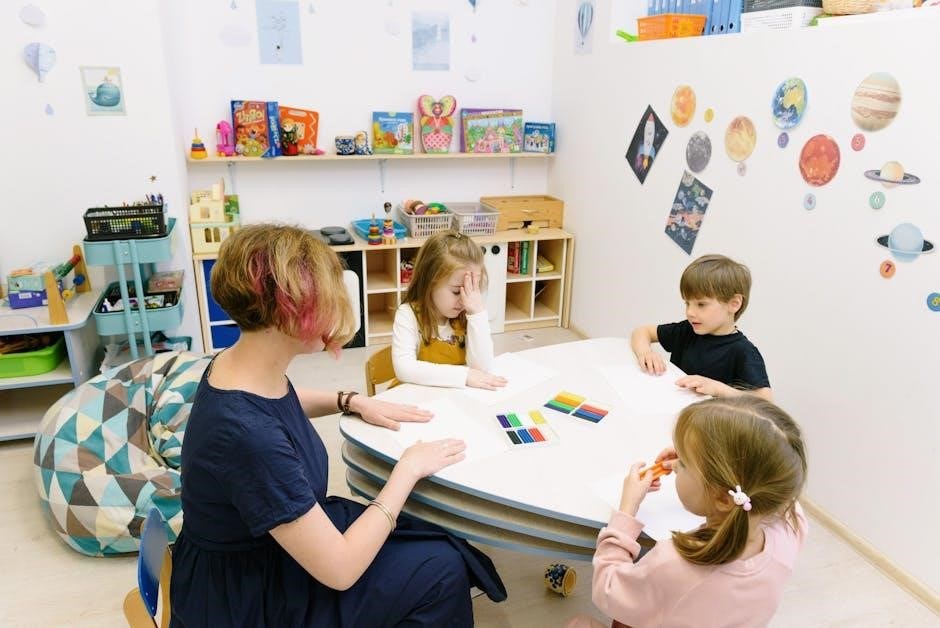GDScript and Godot 4 offer a powerful combination for creating games. GDScript, similar to Python, is easy to learn, making it ideal for beginners and experienced developers alike. Godot 4’s engine provides a robust framework for building games efficiently, with features like nodes, scenes, and a user-friendly interface. This guide will help you master GDScript and harness Godot 4’s capabilities to bring your game ideas to life.
Overview of GDScript and Godot 4
GDScript is a lightweight, Python-like scripting language designed for Godot, offering simplicity and flexibility for game development. Godot 4 is an open-source engine with a node-based architecture, enabling efficient scene management and instancing. It supports 2D and 3D game creation, featuring built-in animation systems, physics engines, and a user-friendly interface. GDScript’s syntax is easy to learn, making it accessible for beginners while still powerful for complex projects. Together, they provide a robust framework for developers to create engaging and interactive games efficiently.
Why Use GDScript for Game Development
GDScript is ideal for game development due to its simplicity and integration with Godot. Its Python-like syntax makes it accessible for developers of all levels. GDScript’s dynamic typing and built-in features streamline game logic implementation. It supports object-oriented programming and is optimized for performance in Godot’s engine. The language’s flexibility and extensive community resources make it a practical choice for rapid prototyping and creating complex game mechanics, ensuring a smooth development experience.

Setting Up the Development Environment
Setting up Godot 4 and GDScript is straightforward. Download and install Godot Engine from the official website. Familiarize yourself with the interface, including the scene editor and script editor. Create a new project and explore the file structure. Install necessary plugins for enhanced functionality. Set up your code editor with GDScript syntax support. Test your setup by running a simple project to ensure everything works smoothly. This environment is ready for building games efficiently with GDScript and Godot 4.

GDScript Basics
GDScript is a lightweight, Python-like language designed for game development. It supports variables, loops, and functions, making it easy to learn and integrate with Godot.
Understanding GDScript Syntax
GDScript’s syntax is clean and Python-like, using indentation for code blocks. Variables are declared with var, and loops include for, while, and match for pattern matching. Functions are defined with func and can return values. Built-in functions simplify common tasks, making scripting intuitive and efficient for Godot 4 game development.
Variables, Data Types, and Operators
In GDScript, variables are declared using var or let, with dynamic typing. Common data types include integers, strings, booleans, and collections like arrays and dictionaries. Operators include arithmetic (+, -, *), comparison (==, !=, <), and logical operators (and, or, not). These tools allow for flexible and intuitive scripting, enabling developers to create complex logic and interactions in their games with ease.
Control Flow and Conditional Statements
GDScript provides robust control flow mechanisms, including if-else statements for conditional execution and switch statements for multiple conditions. Loops like for, while, and foreach enable iteration over data structures. Conditional statements allow developers to make decisions based on game state or user input, while loops facilitate repetitive tasks. These tools are essential for creating dynamic gameplay mechanics, such as enemy AI, player interactions, and level progression, ensuring a responsive and engaging gaming experience.
Functions and Methods in GDScript
Functions in GDScript are reusable code blocks that perform specific tasks. They can accept arguments and return values, making them versatile for organizing complex logic. Built-in methods from Godot’s Node system simplify tasks like node transformations or animation handling. Custom functions enable developers to encapsulate unique behaviors, improving code readability and reusability. This modular approach streamlines development, allowing efficient implementation of game mechanics and reducing code duplication for a cleaner, more maintainable project structure.
Object-Oriented Programming in GDScript
GDScript supports object-oriented programming concepts like classes, objects, inheritance, and polymorphism. These features enable developers to create structured, reusable, and modular code, enhancing game development efficiency and scalability.
Classes and Objects
In GDScript, classes are templates defining properties and behaviors, while objects are instances of these classes. A class can be created using the class keyword, enabling code reuse. Objects inherit attributes and methods from their class, allowing for modular and scalable code. For example, a Player class can have properties like health and methods like move. This OOP approach simplifies game development by organizing code into logical, reusable components.
Inheritance and Polymorphism
In GDScript, inheritance allows a class to inherit properties and methods from another class, promoting code reuse. Polymorphism enables objects to take multiple forms, with methods behaving differently based on context. Together, these OOP concepts enhance flexibility and modularity in game development. For example, a Character class can inherit from Entity and override methods like attack, making it easier to create varied behaviors for different character types in your game.
Encapsulation and Abstraction
Encapsulation in GDScript involves bundling data and methods into a single unit, like a class, to protect internal states and expose only necessary details. Abstraction simplifies complexity by showing only essential features while hiding non-essential ones. Together, these concepts help organize code, improve security, and enhance modularity. For instance, a Player class can encapsulate health and movement logic, while abstracting complex calculations for a cleaner interface, making your game code more maintainable and scalable.

Godot 4 Node System
Nodes are the core elements in Godot 4, representing objects like sprites or labels. Scenes organize nodes hierarchically, forming the game structure. This tree-like system simplifies object management.
Understanding Nodes and Scenes
In Godot 4, a node is the building block of every object in your game, representing entities like sprites, labels, or even empty containers. A scene is a collection of nodes organized in a hierarchical structure, defining how objects interact. Scenes can be saved and reused, making it easy to create modular game components. Nodes communicate through signals, enabling complex behaviors. This system allows developers to design games efficiently by managing objects visually and programmatically.
Node Structure and Hierarchy
In Godot 4, the node structure is a parent-child hierarchy where nodes are organized to define relationships and inheritance. Each node can have multiple children, and properties like position and scale can cascade down. This hierarchy simplifies management and allows for efficient organization of complex game objects. For example, a character node might contain sprite, collision, and animation nodes. Understanding this structure is crucial for designing and managing scenes effectively in your game development process with Godot 4.
Scene Management and Instancing
Scene management in Godot 4 involves loading, unloading, and switching between scenes dynamically. This is essential for organizing game levels, menus, and other components. Instancing allows creating multiple copies of a scene, useful for reusing assets like enemies or obstacles. Efficient scene management optimizes memory usage and performance. Use functions like `load`, `preload`, and `queue_free` to handle scenes. Proper management ensures smooth transitions and scalability in your game development process with Godot 4.

Signals and Events in Godot 4
Signals and events in Godot 4 facilitate effective node communication, enhancing game development through dynamic interactions. Mastering them is crucial for building interactive games effectively.
Signals and events are core concepts in Godot 4, enabling nodes to communicate and respond to actions. Signals are emitted by nodes to notify other parts of the game, while events represent user interactions like keyboard inputs or mouse clicks. Understanding how to work with signals and events is essential for creating interactive and dynamic game elements. This section will explore how signals and events work together to enhance game interactivity and responsiveness, streamlining the development process with GDScript.
Connecting Signals to Scripts
Connecting signals to scripts allows nodes to trigger specific functions in response to events. In Godot 4, signals can be linked to GDScript functions using the signal connector or through code. This enables nodes to communicate and execute logic when events occur, such as button presses or animations finishing. Properly connecting signals enhances game interactivity by ensuring that actions are synchronized with visual or auditory feedback, making the gameplay experience more dynamic and responsive for players.
Custom Signals and Event Handling
Custom signals in GDScript enable developers to create unique events tailored to their game’s needs. These signals can be defined within scripts and emitted when specific conditions are met. By connecting custom signals to functions, developers can handle complex interactions and decouple code logic. This approach enhances flexibility, allowing for better organization of event-driven behaviors. Custom signals are particularly useful for managing state changes, animation triggers, or user-defined actions, making the game logic more modular and easier to maintain.

State Machines and Behavior Trees
State machines and behavior trees are essential for managing complex game logic and AI behaviors, enabling dynamic transitions and decision-making processes in game development.

State Machines in Godot 4
State machines in Godot 4 are powerful tools for managing game logic and AI behaviors. They allow entities to transition between states based on conditions or events. The built-in StateMachine node simplifies creating and managing these transitions, enabling efficient organization of complex behaviors. By defining states and their interactions, developers can create dynamic and responsive systems. This approach is particularly useful for character AI, animation control, and handling user inputs. State machines ensure clean, scalable, and maintainable code, making them a cornerstone of modern game development in Godot.
Behavior Trees for AI
Behavior trees are a popular method for creating AI decision-making systems in games. They provide a visual, hierarchical structure for defining complex behaviors, making it easier to manage and debug AI logic. Unlike state machines, behavior trees focus on task execution and prioritization. Nodes such as tasks, decorators, and composites work together to evaluate conditions and execute actions. Godot 4 supports behavior trees through plugins or custom implementations, enabling developers to design sophisticated AI behaviors efficiently. This approach promotes scalability and maintainability in game AI development.
Implementing State Machines in GDScript
State machines are essential for managing game entity behaviors, such as idle, walking, or attacking states. In GDScript, you can implement state machines using enums to define states and functions to handle transitions. Godot 4 supports this by leveraging node signals and custom scripts. By organizing code into states and transitions, developers can create clean, maintainable logic. State machines are extendable and can be combined with behavior trees for more complex AI systems, ensuring efficient state management in game development projects.

Animation and Physics
Godot 4’s animation system supports keyframe, cut-out, and rigged animations. Physics engines handle collisions, rigid bodies, and constraints, enabling realistic simulations. GDScript integrates seamlessly with both systems.
Animation System in Godot 4
Godot 4’s animation system offers powerful tools like the AnimationPlayer node for keyframe animations, animation trees for state management, and blend spaces for smooth transitions. It supports both 2D and 3D animations, allowing for detailed control over sprites, rigs, and particle effects. The timeline editor enables precise animation editing, while the animation library simplifies organization. GDScript can be used to trigger, control, and synchronize animations, making it easy to integrate animations into gameplay mechanics and create engaging visual experiences.
Physics Engines and Collision Detection
Godot 4 features advanced physics engines for 2D and 3D games, utilizing Bullet Physics for realistic simulations. Collision detection is handled through shape casting, ray casting, and overlap queries. The engine supports rigid body dynamics, character controllers, and vehicle physics. GDScript integrates seamlessly with physics nodes, allowing developers to script collisions, triggers, and physics-based interactions. Built-in collision shapes and layers enhance efficiency, ensuring accurate and performant physics handling in various game scenarios.
Scripting Animations and Physics
Scripting animations and physics in Godot 4 is streamlined using GDScript. The AnimationPlayer node allows for precise control over animation timelines, while the Tween node simplifies transitions. Physics bodies can be manipulated via scripts to apply forces, torques, and velocities. Collision detection is handled through signals, enabling real-time responses to interactions. GDScript’s syntax makes it easy to synchronize animations with physics events, creating dynamic and immersive gameplay experiences. This integration enhances workflow and reduces complexity in game development.

Input Handling and User Interface
Mastering input handling and UI design is crucial for interactive games. Godot 4’s InputMap simplifies action binding, while UI nodes like Button and Label enable intuitive interfaces. GDScript seamlessly integrates event-driven programming for responsive controls and dynamic UI updates, enhancing player interaction and overall user experience in your game development projects.
Input Actions and Event Handling
Input actions and event handling are essential for creating interactive experiences. Godot 4’s InputMap allows defining custom actions, like jumping or shooting, and maps them to keys or buttons. Events are triggered by player actions, such as key presses or mouse movements, and can be detected using GDScript functions. This system enables scalable and customizable controls, supporting various devices and ensuring responsive gameplay. Properly managing these inputs enhances player interaction and overall game functionality.
Creating User Interfaces with Godot
Godot provides a powerful system for creating user interfaces using nodes like Control, Label, and Button. The engine supports anchoring and margin tools for precise layout control. You can design responsive UIs with containers like HBoxContainer and VBoxContainer. Stylesheets enable consistent theming, while custom fonts and colors enhance visual appeal. Godot’s node-based system allows for complex, interactive interfaces tailored to your game’s needs, ensuring a seamless player experience with minimal coding effort required.
Scripting UI Elements
Scripting UI elements in Godot 4 allows for dynamic interaction with your game’s interface. Using GDScript, you can respond to user input, manipulate UI properties, and control visibility. Buttons, sliders, and text fields can trigger custom functions via signal connections. For example, a button press can update a label or enable a new UI element. Scripts can also modify styles, colors, or layouts dynamically, creating immersive and responsive user experiences tailored to your game’s requirements and player interactions.

Advanced Topics
Explore advanced techniques to enhance your game development skills, including optimization, AI scripting, and multiplayer networking. Master these concepts to create sophisticated and efficient games.
Optimization Techniques for Godot 4
Optimize your Godot 4 projects for better performance by reducing draw calls, using batching, and leveraging the engine’s built-in physics optimizations. Implement efficient memory management by utilizing texture atlasing and minimizing unnecessary node creation. Use profiling tools to identify bottlenecks and apply scripting optimizations like avoiding unnecessary calculations. Follow best practices for scene organization and asset management to ensure smooth gameplay across devices. Regularly test and refine your project to maintain peak performance without compromising functionality or visuals.
Scripting AI Behaviors
Scripting AI behaviors in Godot 4 with GDScript allows you to create intelligent NPC interactions. Use state machines to define AI states like idle, chase, and attack. Implement behavior trees for complex decision-making processes. Utilize pathfinding algorithms for navigation and collision avoidance. Leverage built-in features like navigation meshes for efficient path planning. Script custom AI logic using GDScript, including movement patterns and sensory systems. Test and refine AI behaviors to ensure realistic and engaging interactions within your game environment.
Networking and Multiplayer Basics
Networking and multiplayer basics in Godot 4 involve setting up real-time communication between players. Use built-in networking features to synchronize game states and handle player inputs. Implement multiplayer scenes with NetworkedSceneManager for efficient synchronization. Manage client-server architecture and handle latency issues. Use GDScript to script network events and remote procedure calls. Ensure secure communication and error handling for disconnects. Follow best practices for optimizations to maintain smooth multiplayer experiences and fair gameplay across connected devices.
Mastering GDScript and Godot 4 empowers you to create engaging games. This guide provides a solid foundation, from basics to advanced topics, ensuring a comprehensive learning journey.
Best Practices for Learning GDScript
Start with simple projects to grasp fundamentals. Experiment in Godot’s script editor for hands-on learning. Use the official documentation and community resources. Join forums and groups for support. Practice regularly to build confidence. Focus on understanding concepts before moving to complex tasks. Collaborate on small projects to apply skills. Review and refactor code to improve quality. Stay updated with Godot 4 updates and features. Consistency is key to mastering GDScript effectively.
Next Steps in Game Development
After mastering GDScript, focus on building small but complete game projects to apply your skills. Experiment with Godot 4’s advanced features like animation systems and physics. Explore game design principles, including level design and user experience. Join game development communities for feedback and collaboration. Consider creating a portfolio on platforms like GitHub or Itch.io. Continuously challenge yourself by tackling new genres or mechanics to expand your expertise and creativity in game development.
Resources for Further Learning
Explore the official Godot documentation for in-depth guides and tutorials. Utilize community-driven platforms like the Godot Asset Library for scripts and templates. Join forums such as Reddit’s r/godot for peer support and feedback. YouTube channels like GameDev.net and Heartbeast offer video tutorials. Check out books on GDScript and Godot 4 from Amazon. Enroll in courses on Udemy or Coursera to deepen your skills. Visit the Godot GitHub repository for open-source projects and examples to learn from and adapt.
